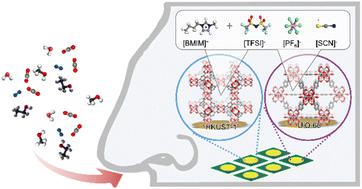当前位置:
X-MOL 学术
›
J. Mater. Chem. A
›
论文详情
Our official English website, www.x-mol.net, welcomes your
feedback! (Note: you will need to create a separate account there.)
A MOF-based electronic nose for carbon dioxide sensing with enhanced affinity and selectivity by ionic-liquid embedment
Journal of Materials Chemistry A ( IF 10.7 ) Pub Date : 2022-11-28 , DOI: 10.1039/d2ta06324g Peng Qin 1 , Salih Okur 1 , Yunzhe Jiang 1 , Lars Heinke 1
Journal of Materials Chemistry A ( IF 10.7 ) Pub Date : 2022-11-28 , DOI: 10.1039/d2ta06324g Peng Qin 1 , Salih Okur 1 , Yunzhe Jiang 1 , Lars Heinke 1
Affiliation

|
The unequivocal detection of CO2 is important in many situations, like in the living environment, plant cultivation and the conservation of cultural relics and archives. Due to their large specific surface areas and highly ordered and tunable structures, metal–organic frameworks (MOFs) have the potential to improve CO2 sensing, however, they often suffer from low CO2 affinity and selectivity. Ionic liquids (ILs) have high CO2 affinity, but their performance in sensors is hampered by their nonporous, liquid form. Here, we present a low-cost and portable CO2 sensor system based on an array of gravimetric sensors made of MOF films with embedded ILs in the pores. The array is composed of MOF films of two different structures, which are HKUST-1 and UiO-66, filled with 3 different types of ILs and 2 different pore-filling levels, resulting in an array of up to 14 different sensors. We show that the different combinations of IL and MOF result in different affinities for CO2 and other analytes. With the help of machine learning using a neural network, the sensor array was used to quantify the CO2 concentration as well as to distinguish CO2 from other gases and vapors, like nitrogen, ethanol, methanol and water, and to distinguish certain binary mixtures. While the MOF-sensor array without IL achieves only a small accuracy for determining the CO2 concentration, the IL@MOF sensor array can accurately classify the gas types (98% accuracy) in mixed gas atmospheres of unknown composition and concentration as well as can determine the CO2 gas concentration with an average error of only 2.7%. Using only MOFs with a pronounced chemical stability (like UiO-66) in the sensor array also allows the detection and identification of CO2 in a humid atmosphere. Moreover, the presented sensor system has very high sensitivity with a CO2 limit of detection below 100 ppm, which is four times smaller than the CO2 concentration in air. This work shows the unprecedented performance of the sensor arrays of MOFs with embedded ILs, referred to as IL@MOF-electronic nose (IL@MOF-e-nose), for sensing the composition and concentration of CO2 gas mixtures.
中文翻译:

一种基于 MOF 的二氧化碳传感电子鼻,通过离子液体嵌入增强了亲和力和选择性
CO 2的明确检测在许多情况下都很重要,例如在生活环境、植物栽培以及文物和档案保护中。由于其较大的比表面积和高度有序且可调的结构,金属有机框架 (MOF) 具有改善 CO 2传感的潜力,但是,它们通常具有较低的 CO 2亲和力和选择性。离子液体 (IL) 具有高 CO 2亲和力,但它们在传感器中的性能受到其无孔液体形式的阻碍。在这里,我们提出了一种低成本的便携式 CO 2传感器系统基于一系列重力传感器,这些传感器由 MOF 薄膜制成,孔中嵌入了离子液体。该阵列由 HKUST-1 和 UiO-66 两种不同结构的 MOF 薄膜组成,填充了 3 种不同类型的 IL 和 2 种不同的孔隙填充水平,从而形成多达 14 个不同传感器的阵列。我们表明,IL 和 MOF 的不同组合会导致对 CO 2和其他分析物的不同亲和力。借助使用神经网络的机器学习,传感器阵列用于量化 CO 2浓度以及区分 CO 2与其他气体和蒸汽,如氮气、乙醇、甲醇和水,以及区分某些二元混合物。虽然没有 IL 的 MOF 传感器阵列在确定 CO 2浓度方面的精度很小,但 IL@MOF 传感器阵列可以在成分和浓度未知的混合气体环境中准确地对气体类型进行分类(准确度为 98%),并且可以确定 CO 2气体浓度,平均误差仅为 2.7%。在传感器阵列中仅使用具有显着化学稳定性的 MOF(如 UiO-66)还可以检测和识别潮湿大气中的 CO 2。此外,所呈现的传感器系统对 CO 2具有非常高的灵敏度检测限低于 100 ppm,比空气中的 CO 2浓度小四倍。这项工作展示了具有嵌入式 IL 的 MOF 传感器阵列的前所未有的性能,称为 IL@MOF-电子鼻 (IL@MOF-e-nose),用于检测 CO 2气体混合物的成分和浓度。
更新日期:2022-11-28
中文翻译:

一种基于 MOF 的二氧化碳传感电子鼻,通过离子液体嵌入增强了亲和力和选择性
CO 2的明确检测在许多情况下都很重要,例如在生活环境、植物栽培以及文物和档案保护中。由于其较大的比表面积和高度有序且可调的结构,金属有机框架 (MOF) 具有改善 CO 2传感的潜力,但是,它们通常具有较低的 CO 2亲和力和选择性。离子液体 (IL) 具有高 CO 2亲和力,但它们在传感器中的性能受到其无孔液体形式的阻碍。在这里,我们提出了一种低成本的便携式 CO 2传感器系统基于一系列重力传感器,这些传感器由 MOF 薄膜制成,孔中嵌入了离子液体。该阵列由 HKUST-1 和 UiO-66 两种不同结构的 MOF 薄膜组成,填充了 3 种不同类型的 IL 和 2 种不同的孔隙填充水平,从而形成多达 14 个不同传感器的阵列。我们表明,IL 和 MOF 的不同组合会导致对 CO 2和其他分析物的不同亲和力。借助使用神经网络的机器学习,传感器阵列用于量化 CO 2浓度以及区分 CO 2与其他气体和蒸汽,如氮气、乙醇、甲醇和水,以及区分某些二元混合物。虽然没有 IL 的 MOF 传感器阵列在确定 CO 2浓度方面的精度很小,但 IL@MOF 传感器阵列可以在成分和浓度未知的混合气体环境中准确地对气体类型进行分类(准确度为 98%),并且可以确定 CO 2气体浓度,平均误差仅为 2.7%。在传感器阵列中仅使用具有显着化学稳定性的 MOF(如 UiO-66)还可以检测和识别潮湿大气中的 CO 2。此外,所呈现的传感器系统对 CO 2具有非常高的灵敏度检测限低于 100 ppm,比空气中的 CO 2浓度小四倍。这项工作展示了具有嵌入式 IL 的 MOF 传感器阵列的前所未有的性能,称为 IL@MOF-电子鼻 (IL@MOF-e-nose),用于检测 CO 2气体混合物的成分和浓度。











































 京公网安备 11010802027423号
京公网安备 11010802027423号